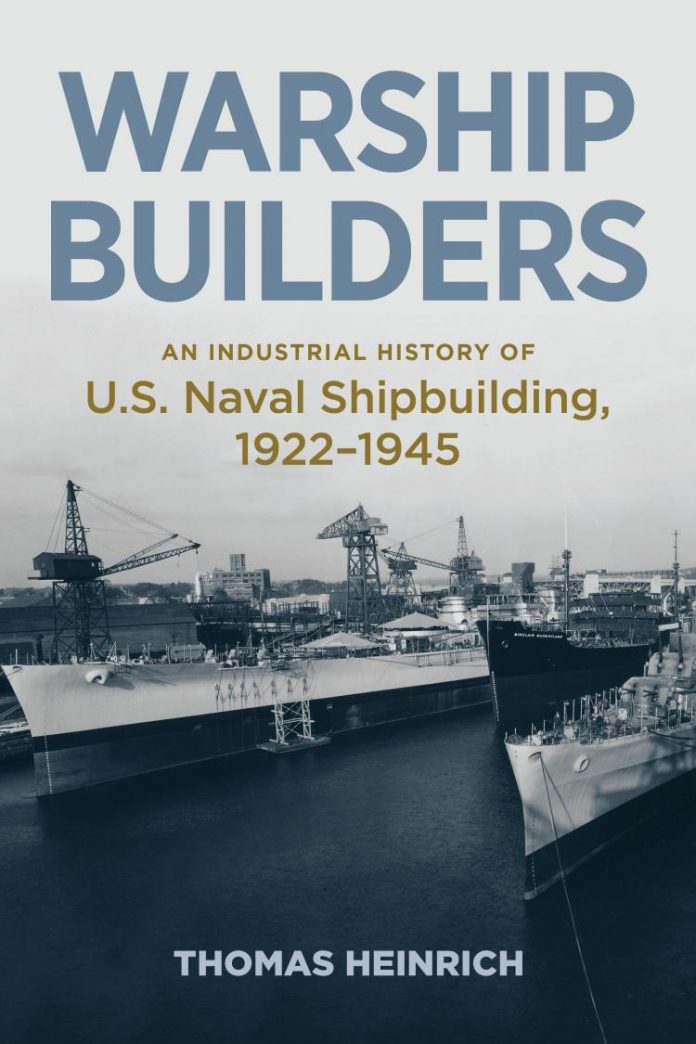
Warship Builders: An Industrial History of U.S. Naval Shipbuilding 1922–1945. Studies in Naval History and Sea Power. By Thomas Heinrich. Naval Institute Press, Annapolis, 2020
Reviewed by Mark Bailey PhD
This is a neatly produced book in USNI’s Studies and Naval History and Sea Power series, edited by Christopher Bell and James Bradford. The series covers the unusual and more in-depth or specialised topics.
The book itself accords to USNI’s wish for economy in publishing so as to keep prices affordable. As is now the USNI standard, this is noticeable in the book’s illustrations and paper choice.
Dr Heinrich has written both an excellent reference and a comparative industrial history regarding how the US, Royal, Imperial Japanese and German navies of the WWII era developed. This adds to important recent works such as Ian Buxton and Ian Johnston’s ‘The Battleship Builders’. Heinrich’s examination of the industrial systems behind the four navies adds much to understanding their relative performances during WWII. While Dr Heinrich does focus mostly on the US warship building effort, his contrasts with the other three powers add great depth and value to the work. One of the main values of the book is the explanation of batch production and how the differences between yard procedures, design, workflow and management processes resulted in ships of the same class being quite different in construction details.
While many ship classes are discussed, two are used as case studies; the Iowa class battleships and Cleveland class cruisers. The story of how they were designed and constructed, how problems were encountered and overcome and details of other industrial production processes provide a clear snapshot of how the USA was able to manage explosive growth in the scale of complex production processes. There is much food for thought in this work about the sheer complexity of war mobilisation.
Warship Builders is a significant scholarly study. It is obvious that much more research was conducted than could be presented, and that the notable gaps in this work exist because there was insufficient space to include that coverage. One of these is comparative costs: why US warship unit costs were far higher than British costs. While some of the minutiae of yard management might interest may not be the most interesting subject to some, this careful use of critical detail is central to what Dr Heinrich’s research has revealed.
Dr Heinrich’s use of comparative analyses reveals both differences and similarities in US, British, Japanese and German naval construction and the differing outcomes obtained. For example, Heinrich shows that while US and German shipyards introduced electric arc welding and prefabrication methods to a greater extent than their British and Japanese counterparts before 1939, the US focus on welding was far more successful than the German. It is here that an examination of comparative cost might reveal why British yards could build technologically equivalent warships more cheaply than could the US with their superior managerial and batch production methods. There were other differences which Heinrich has clearly examined but again lacked space to explore. For example, the US and Japanese navies relied heavily on government-owned navy yards, but the British and German navies constructed most of their warships in corporately-owned yards. This contradicts the historical myth that US industrial mobilisation depended on private enterprise. Heinrich covers the enormous scale of US government investment into shipbuilding facilities in both private and government-owned. This dwarfed the investment of their British, Japanese, and German counterparts and was a central factor in enabling US builders to deliver the flood of warships ordered in US yards.
Warship Builders is a valuable addition to historiography of WWII and is a rare industrial history. It will be essential to anyone interested in how the USA, Britain, Japan and Germany developed the capabilities they required to fight WWII. It is recommended to members of the ANI as it provides a new lens through which to see the ear at sea during WWII.



